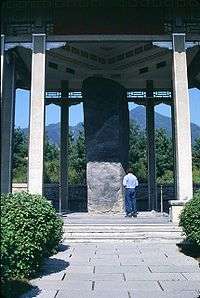Taewang
Taewang (태왕; 太王), literally meaning "Greatest King", was an imperial title used in Goguryeo, one of the Three Kingdoms of Korea, by rulers such as Gwanggaeto the Great and Jangsu.[1][2] Taewang was equivalent to "emperor" and indicated the independent worldview of Goguryeo,[3] which, based on epitaphs dating to the 4th and 5th centuries, had concepts of Son of Heaven (天帝之子) and independent tianxia.[4][5][6] The title Seongwang (성왕; 聖王), literally meaning "Holy King", was also used in Goguryeo.[7]
| Taewang | |
| Hangul | 태왕 |
|---|---|
| Hanja | 太王 |
| Revised Romanization | Taewang |
| McCune–Reischauer | T'aewang |
Some rulers of Silla, such as Beopheung and Jinheung, used the title of Taewang as well.[8]
Gallery
 Gwanggaeto Stele, inscribed with "Taewang", referring to Gwanggaeto the Great
Gwanggaeto Stele, inscribed with "Taewang", referring to Gwanggaeto the Great Bronze bowl discovered in a Silla royal tomb, inscribed with "Taewang", referring to Gwanggaeto the Great[9]
Bronze bowl discovered in a Silla royal tomb, inscribed with "Taewang", referring to Gwanggaeto the Great[9]
See also
References
- Youn, Myung Chul (2014). "Beauty, meaning, and logics Reflected on King Gwanggaeto's Monument". Journal of Dangun Studies (in Kanuri). 30 (30): 283–336. ISSN 1229-893X. Retrieved 19 February 2019.
- "중원고구려비(中原高句麗碑)". 한국금석문 종합영상정보시스템. National Research Institute of Cultural Heritage. Retrieved 19 February 2019.
- "Goguryeo's Worldview and Three Kingdoms". Korea Now. Korea Herald. 33: 32. 2004. Retrieved 19 February 2019.
They called their king "taewang" ("the greatest king"). Taewang was a title equivalent to "emperor" and referred to the ruler of the entire world of Goguryeo. In short, the practice of calling their king "taewang" was based on Goguryeo's independent worldview.
- Yeongkwang, Jo (2015). "Status and Tasks for Study of the Foreign Relations and World View of Koguryo in the Gwanggaeto Stele". Dongbuga Yeoksa Nonchong (in Korean) (49): 70–76. ISSN 1975-7840. Retrieved 3 November 2018.
- "고구려의 천하관". 우리역사넷 (in Korean). National Institute of Korean History. Retrieved 3 November 2018.
- "장수왕의 남진 정책". 우리역사넷. National Institute of Korean History. Retrieved 6 December 2018.
- "광개토왕(廣開土王)(고구려) (談德)". 한국사 콘텐츠. National Institute of Korean History. Retrieved 19 February 2019.
- "(1) 대왕호의 사용과 연호의 제정". 우리역사넷. National Institute of Korean History. Retrieved 13 January 2019.
- "경주 호우총 출토 청동 '광개토대왕'명 호우 (慶州 壺杅塚 出土 靑銅 '廣開土大王'銘 壺杅)". 국가문화유산포탈. Cultural Heritage Administration. Retrieved 19 February 2019.
This article is issued from Wikipedia. The text is licensed under Creative Commons - Attribution - Sharealike. Additional terms may apply for the media files.